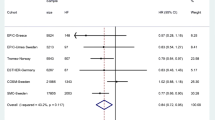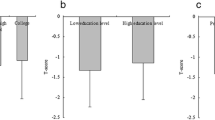Abstract
Summary
We examined educational disparities in use of osteoporosis drugs in a nationwide population of Swedes aged 75–89 years old. Individuals with high education were more likely to receive osteoporosis drug treatment than lower educated individuals, particularly among women.
Introduction
This study aims to investigate whether educational level is associated with use of osteoporosis drugs in the general population of older men and women in Sweden, also after adjustment for fractures.
Methods
By record linkage of The Swedish Prescribed Drug Register, The Swedish Patient Register, and The Swedish Education Register, we obtained information on filling of prescriptions for osteoporosis drugs (bisphosphonates, calcium/vitamin D combinations, and selective estrogen receptor modulators) from July to October 2005, osteoporotic fractures from 1998 to 2004, and educational level for 645,429 people aged 75–89 years. Multivariate logistic regression analysis was used to investigate whether education was associated with use of osteoporosis drug therapy.
Results
Higher education was associated with use of osteoporosis drugs for both men [odds ratio (OR)high education vs low, 1.27; 95% confidence interval (CI), 1.19–1.35] and women (ORhigh education vs low, 1.57; 95% CI, 1.52–1.61), after adjustment for age, osteoporotic fractures, and comorbidity (i.e., number of other drugs). Among those who had sustained a fracture (n = 57,613), the educational differences in osteoporosis drug treatment were more pronounced in women than men. Further, women were more likely to receive osteoporosis drug treatment after osteoporotic fracture.
Conclusion
Uptake of osteoporosis drug therapy seems to be unequally distributed in the elderly population, even in a country with presumably equal access to health care.
Similar content being viewed by others
References
Genant HK, Cooper C, Poor G, Reid I, Ehrlich G, Kanis J, Nordin BEC, Barrett-Connor E, Black D, Bonjour JP (1999) Interim report and recommendations of the World Health Organization task-force for osteoporosis. Osteoporos Int 10:259–264
Cooper C, Campion G, Melton LJ (1992) Hip fractures in the elderly: a world-wide projection. Osteoporos Int 2:285–289
Borgström F, Sobocki P, Ström O, Jönsson B (2007) The societal burden of osteoporosis in Sweden. Bone 40:1602–1609
Borgström F, Zethraeus N, Johnell O, Lidgren L, Ponzer S, Svensson O, Abdon P, Ornstein E, Lunsjö K, Thorngren KG (2006) Costs and quality of life associated with osteoporosis-related fractures in Sweden. Osteoporos Int 17:637–650
Kanis J, Burlet N, Cooper C, Delmas P, Reginster JY, Borgstrom F, Rizzoli R (2008) European guidance for the diagnosis and management of osteoporosis in postmenopausal women. Osteoporos Int 19:399–428
Kanis J, Johnell O, De Laet C, Jonsson B, Oden A, Ogelsby AK (2002) International variations in hip fracture probabilities: implications for risk assessment. J Bone Miner Res 17:1237–1244
Kanis J, Johnell O, Oden A, Dawson A, De Laet C, Jonsson B (2001) Ten year probabilities of osteoporotic fractures according to BMD and diagnostic thresholds. Osteoporos Int 12:989–995
Brennan S, Pasco J, Urquhart D, Oldenburg B, Hanna F, Wluka A (2009) The association between socioeconomic status and osteoporotic fracture in population-based adults: a systematic review. Osteoporos Int 20:1487–1497
Brennan S, Pasco J, Urquhart D, Oldenburg B, Wang Y, Wluka A (2011) Association between socioeconomic status and bone mineral density in adults: a systematic review. Osteoporos Int 22:517–527
Ström O, Borgström F, Sen S, Boonen S, Haentjens P, Johnell O, Kanis J (2007) Cost-effectiveness of alendronate in the treatment of postmenopausal women in 9 European countries—an economic evaluation based on the fracture intervention trial. Osteoporos Int 18:1047–1061
SBU (The Swedish Council on Technology Assessment in Health Care) (2003) Osteoporosis—prevention, diagnosis and treatment. A sytematic review. SBU, Göteborg
Semerano L, Guillot X, Rossini M, Avice E, Bégué T, Wargon M, Boissier M, Saidenberg-Kermanac’h N (2011) What predicts initiation of osteoporosis treatment after fractures: education organisation or patients’ characteristics? Clin Exp Rheumatol 29:89–92
Brennan RM, Wactawski-Wende J, Crespo CJ, Dmochowski J (2004) Factors associated with treatment initiation after osteoporosis screening. Am J Epidemiol 160:475–483
Unson CG, Fortinsky R, Prestwood K, Reisine S (2005) Osteoporosis medications used by older African-American women: effects of socioeconomic status and psychosocial factors. J Community Health 30:281–297
Vanasse A, Dagenais P, Niyonsenga T, Grégoire JP, Courteau J, Hemiari A (2005) Bone mineral density measurement and osteoporosis treatment after a fragility fracture in older adults: regional variation and determinants of use in Quebec. BMC Musculoskelet Disord 6:33. doi:10.1186/1471-2474-1186-1133
Johnell K, Fastbom J (2009) Undertreatment of osteoporosis in the oldest old? A nationwide study of over 700,000 older people. Arch Osteoporos 4:17–23
Kiebzak GM, Beinart GA, Perser K, Ambrose CG, Siff SJ, Heggeness MH (2002) Undertreatment of osteoporosis in men with hip fracture. Arch Intern Med 162:2217–2222
Wettermark B, Hammar N, MichaelFored C, Leimanis A, Otterblad Olausson P, Bergman U, Persson I, Sundström A, Westerholm B, Rosén M (2007) The new Swedish Prescribed Drug Register—opportunities for pharmacoepidemiological research and experience from the first six months. Pharmacoepidemiol Drug Saf 16:726–735
Naessen T, Parker R, Persson I, Zack M, Adami HO (1989) Time trends in incidence rates of first hip fracture in the Uppsala Health Care Region, Sweden, 1965–1983. Am J Epidemiol 130:289–299
Statistics Sweden (2004) The Swedish Register of Education. http://www.scb.se/statistik/UF/UF0506/SUN2000English%20version.doc. Accessed 26 Mar 2011.
WHO Collaborating Centre for Drug Statistics Methodology, Oslo, Norway (2011) http://www.whocc.no/. Accessed 21 Jun 2011
WHO (2004) ICD-10: International Statistical Classification of Diseases and Related Health Problems: tenth revision, 2nd edn. WHO, Geneva
Häussler B, Gothe H, Göl D, Glaeske G, Pientka L, Felsenberg D (2007) Epidemiology, treatment and costs of osteoporosis in Germany—the BoneEVA Study. Osteoporos Int 18:77–84
Haasum Y, Fastbom J, Fratiglioni L, Johnell K (2012) Undertreatment of osteoporosis in persons with dementia? A population-based study. Osteoporos Int 23:1061–1068
Johnell K, Weitoft GR, Fastbom J (2009) Sex differences in inappropriate drug use: a register-based study of over 600,000 older people. Ann Pharmacother 43:1233–1238
Schneeweiss S, Seeger JD, Maclure M, Wang PS, Avorn J, Glynn RJ (2001) Performance of comorbidity scores to control for confounding in epidemiologic studies using claims data. Am J Epidemiol 154:854–864
Haider SI, Johnell K, Ringbäck Weitoft G, Thorslund M, Fastbom J (2008) Patient educational level and use of newly marketed drugs: a register-based study of over 600,000 older people. Eur J Clin Pharmacol 64:1215–1222
Engel P, Fabre A, Fournier A, Mesrine S, Boutron-Ruault MC, Clavel-Chapelon F (2011) Risk of osteoporotic fractures after discontinuation of menopausal hormone therapy: results from the E3N cohort. Am J Epidemiol 174:12–21
Merlo J, Lynch JW, Yang M, Lindström M, Östergren PO, Rasmusen NK, Råstam L (2003) Effect of neighborhood social participation on individual use of hormone replacement therapy and antihypertensive medication: a multilevel analysis. Am J Epidemiol 157:774–783
Solomon DH, Brookhart MA, Gandhi TK, Karson A, Gharib S, Orav EJ, Shaykevich S, Licari A, Cabral D, Bates DW (2004) Adherence with osteoporosis practice guidelines: a multilevel analysis of patient, physician, and practice setting characteristics. Am J Med 117:919–924
Stocks NP, Ryan P, Elroy H, Allan JA (2004) Statin prescribing in Australia: socioeconomic and sex differences—a cross-sectional study. Med J Aust 180:229–231
Johnell K, Ringbäck Weitoft G, Fastbom J (2008) Education and use of dementia drugs: a register-based study of over 600,000 older people. Dement Geriatr Cogn Disord 25:54–59
Taylor SE, Repetti RL, Seeman T (1997) Health psychology: what is an unhealthy environment and how does it get under the skin? Annu Rev Psychol 48:411–447
Ohlsson H, Lynch K, Merlo J (2010) Is the physician’s adherence to prescription guidelines associated with the patient’s socio-economic position? An analysis of statin prescription in South Sweden. J Epidemiol Community Health 64:678–683
Galobardes B, Lynch J, Smith GD (2007) Measuring socioeconomic position in health research. Br Med Bull 81:21–37
Aging Research Center, Karolinska Institutet, Stockholm University (2007) SWEOLD code book 2002 & 2004. Karolinska Institutet, Stockholm
Elliot-Gibson V, Bogoch E, Jamal S, Beaton D (2004) Practice patterns in the diagnosis and treatment of osteoporosis after a fragility fracture: a systematic review. Osteoporos Int 15:767–778
Johnell O, Kanis J, Oden A, Sernbo I, Redlund-Johnell I, Petterson C, Laet CD, Jönsson B (2004) Mortality after osteoporotic fractures. Osteoporos Int 15:38–42
Nielsen M, Hansen E, Rasmussen N (2003) Prescription and non-prescription medicine use in Denmark: association with socio-economic position. Eur J Clin Pharmacol 59:677–684
Kaufman J (2010) Inequality in provision of medical care in Sweden: a case of social epidemiological hypochondria? J Epidemiol Community Health 64:651–652
Funding
This study was supported by grants from the Swedish Council for Working Life and Social Research (2007–1947) and the Swedish Research Council (2007–5870).
Conflicts of interest
None.
Author information
Authors and Affiliations
Corresponding author
Rights and permissions
About this article
Cite this article
Wastesson, J.W., Ringbäck Weitoft, G., Parker, M.G. et al. Educational level and use of osteoporosis drugs in elderly men and women: a Swedish nationwide register-based study. Osteoporos Int 24, 433–442 (2013). https://doi.org/10.1007/s00198-012-1945-6
Received:
Accepted:
Published:
Issue Date:
DOI: https://doi.org/10.1007/s00198-012-1945-6




